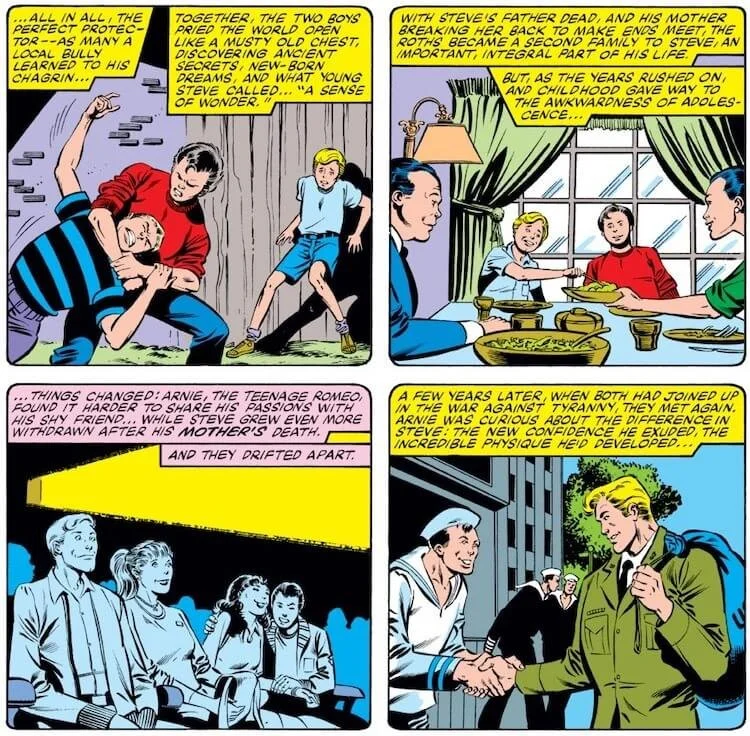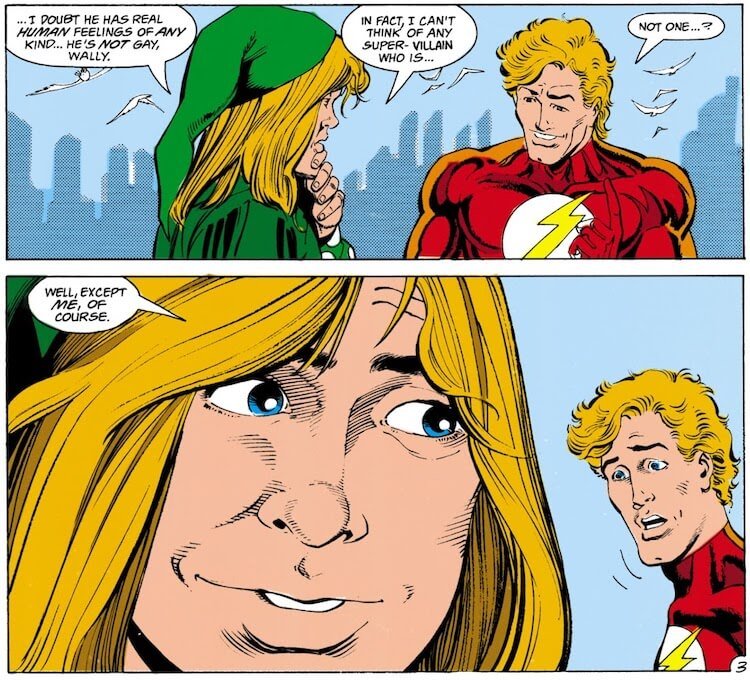Great Moons of Krypton!
The Blog
Here you can find my thoughts on comics, writing craft, comics, musicals, comics, New York City history, and I’ll probably talk about comics, too.
Want that delivered conveniently to your inbox instead? Subscribe to my newsletter to get all of the above, plus monthly updates from me!
Queer Superhero History: The Future Is Gay—Queer Coding in the Legion of Super-Heroes
The Legion of Super-Heroes is a team of (usually) teenage heroes that first appeared in 1958. They operate a thousand years in the future and are closely associated with Superboy; every version of the character has been a member, as well as Supergirl.
Queer Superhero History: Queering the Justice League
All of the characters I’ve covered so far on Queer Superhero History have been fairly obscure, but with today’s profiles, we are finally talking about that most lofty of superhero teams: the Justice League. And yes, okay, Tasmanian Devil and Glacier are not exactly household names. (Well, not DC’s Tasmanian Devil.) But they were still on the Justice League, and during a time when the League seemed much more open to queer identities than it had ever been before — or since, honestly.
Queer Superhero History: John Constantine
John Constantine is a working class magician and occult detective from London. He initially appeared in The Saga of the Swamp Thing #37 (June 1985), and was created by Alan Moore, Steve Bissette, and John Totleben. He was popular enough that in 1988 he got his own series, Hellblazer, which would eventually become the longest-running series of DC’s Vertigo imprint at 300 issues.
Queer Superhero History: The First Trans Characters in Comics
From 1991-1993, DC introduced three trans women in three different comics. They still live in an outlandish comic book world, but their being trans (mostly) has nothing to do with that. Some are handled more gracefully than others, and they are all fairly obscure characters — but they’re also all groundbreaking in their own way.
Queer Superhero History: Monsieur Mallah and the Brain
Who would you say is the longest-lasting queer couple in superhero comics? If you guessed Midnighter and Apollo, you’re close. And there are a number of Marvel couples that flew under the radar for decades before their love dare spoke its name. But if you’re looking for the queer couple that has been explicitly out and explicitly an item for the longest period of time, the winner is…a talking French gorilla and a brain in a jar. And that’s beautiful.
Queer Superhero History: Mystique
Mystique, a.k.a. Raven Darkholme, actually first appeared in Ms. Marvel #16 (April 1978) by Claremont and David Cockrum, though she quickly became a major X-Men villain (and occasional ally). Anyone who only knows Mystique via the movies, where she is mostly a henchwoman for Magneto with little dialogue and less agency, has been misled: Mystique henches for no one. (She also usually…wears clothes.)
Queer Superhero History: Cannon and Saber—Be Gay, Do Crime
Cannon and Saber first appeared in Vigilante #5 (April 1984), by Marv Wolfman and Keith Pollard. Marschall Saber is an assassin who specializes in guns; Henry Cannon is an assassin who specializes in blades. Yes, that is confusing. Also, Saber has the same haircut as Moe from the Three Stooges for some reason.
Queer Superhero History: Cloud
Cloud debuted in The Defenders #123 (June 1983) and was created by J.M. DeMatteis and Don Perlin, though the bulk of their Defenders appearances were written by Peter B. Gillis. Originally, they took the form of a teenage girl — a completely naked one, made Comics Code-compliant by little wisps of cloud hovering around their chest and pelvis. Sigh.
Queer Superhero History: Arnie Roth
Arnie first appeared in Captain America #268 (April 1982), and was created by J. M. DeMatteis and Mike Zeck. He and Steve Rogers were childhood best friends, but polar opposites: while young Steve was scrawny, frail, and awkward around girls, Arnie was strong and popular, protecting Steve from bullies and dragging him around on double dates—the more stereotypically “masculine” of the two. When the war came, Arnie enlisted, and Steve, of course, became Captain America.
Queer Superhero History: Taku and Venomm, Wakandan Husbands Forever
Okay, unless you’re a Black Panther superfan—or a collector of obscure queer-coded superhero-adjacent characters (ahem)—you have probably never heard of these two. They’ve only appeared together in about a dozen issues, scattered over half a century. So why do they merit their own post? Because while there are plenty of characters who spent years or even decades exuding homoerotic subtext from within the confines of the Comics Code, in Taku and Venomm’s case, we know for a fact that that subtext was intentional—even as far back as 1974.
Queer Superhero History: Northstar
Northstar is often called the first gay superhero, although he wasn’t allowed to come out until 13 years after his debut. But he was almost certainly the first mainstream superhero deliberately (albeit subtextually) depicted as queer, he was Marvel’s first gay superhero, and his coming out in 1992 was a landmark event, as was his eventual wedding to his husband, Kyle, 20 years later.
Queer Superhero History: Pied Piper
The Pied Piper is the first costumed character in superhero comics to use the word “gay” in relation to himself. Minor civilian characters had used it before, but never someone from the capes and tights set. He’s also the first canonically queer supervillain (albeit a reformed one), and the first character to come out decades after his introduction, as opposed to being introduced as queer from the get-go.
Queer Superhero History: Maggie Sawyer
Maggie first debuted in Superman #4 (April 1987), and was created by John Byrne. She’s a captain in the Metropolis PD’s Special Crimes Unit (SCU), which deals with superpowered menaces. She becomes a recurring character in the Superman books and eventually, a grudging ally of the Man of Steel’s.
Queer Superhero History: The Comics Code Authority
Publishers would submit their comics to the CCA, and if they met all the requirements of the Code, they would be allowed to publish with a seal on the cover that said “Approved by the Comics Code Authority.” You could absolutely publish a comic without CCA approval, but many retailers wouldn’t carry it if you did. So most publishers bent over backwards to comply.
Queer Superhero History: Extraño
Gregorio de la Vega, better known as Extraño, debuted in 1988 and is the first openly gay superhero in a mainstream comic. Though Extraño and the characters around him never originally used the word “gay,” his publisher, DC Comics, did. And Extraño’s sexuality is repeatedly made perfectly clear in the text, as opposed to being heavily veiled to sneak past the Comics Code Authority.















